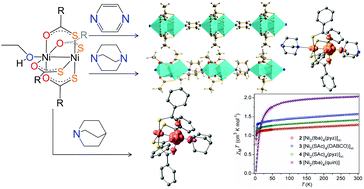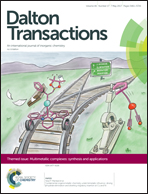Quasi-1D chains of dinickel lantern complexes and their magnetic properties†
Abstract
Four new quasi-1D Ni2-lantern chain complexes of the form [Ni2(SOCR)4(L)]∞ (R = Ph, L = DABCO (1); R = Ph, L = pyz (2); R = CH3, L = DABCO (3); R = CH3, L = pyz (4)) were prepared from the reaction of [Ni2(SOCR)4(EtOH)], R = CH3 or Ph, with the N,N′-donor bridging ligands pyrazine (pyz) or 1,4-diazabicyclo[2.2.2]octane (DABCO). Reaction of [Ni2(tba)4(EtOH)], (tba = thiobenzoate) with the mono-N donor ligand quinuclidine (quin) gave the discrete Ni2-lantern complex [Ni2(tba)4(quin)] (5), whereas reaction with pyridine led to fragmentation of the lantern and formation of the known [Ni(tba)2(py)2] (6). Single-crystal X-ray diffraction reveals 2–4 to be 1D chain complexes comprising DABCO or pyz ligands which bridge the Ni2-lantern units. Complex 5 forms dimers through two equivalent Ni⋯S interactions. The Ni–Ni distances within the Ni2-lanterns are 2.5316(18)–2.595(2) Å for the 1D chain complexes 2–4, and 2.5746(4) Å in the dimeric complex 5, respectively. Comparing the solid state magnetism of 5 to precursor [Ni2(tba)4(EtOH)] demonstrates a change in coupling upon change of capping ligand. Meanwhile, chains 1–4 exhibit magnetic properties consistent with an S = 1 system, due to a mixed valent system where the two Ni centers differ in spin state, while 5 possesses two S = 1 Ni(II) centers. DFT calculations confirm low-spin S = 0 {NiS4} and high-spin S = 1 {NiO4} centers in each lantern. Fits to the magnetic susceptibility data of the chains suggest a weak antiferromagnetic mean field interaction is present that is largely 1-D in nature, though neither pyrazine nor DABCO promote significant magnetic interaction between neighboring Ni2-lanterns.

- This article is part of the themed collection: Multimetallic complexes: synthesis and applications


 Please wait while we load your content...
Please wait while we load your content...